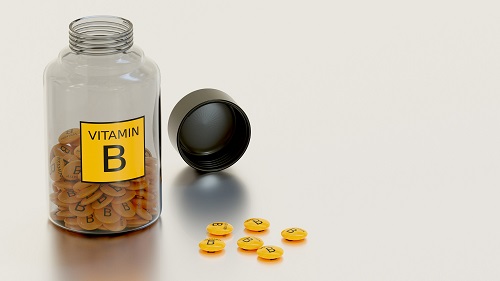
Vitamin B | Deficiency, Function and Dosage
Principal Functions of the B Vitamins
- Energy production from carbohydrates, fats, and protein
- Synthesis of neurotransmitters
- Conversion of amino acids
- Synthesis of fatty acids and hormones
- Antioxidant protection
Vitamins are organic compounds (i.e., contain carbon) and are Vital amines essential for life that must be obtained in the diet because they cannot be synthesized by the body. They are generally classified as water- or fat-soluble and often appear on ingredient lists with either their common or chemical names.
- Fat-soluble vitamins: A (retinol, retinal, retinoic acid), D (calciferol, cholecalciferol), E (tocopherol), and K phylloquinone, menaquinone)
- Fat- soluble vitamins: A (retinol, retinal, retinoic acid), D (calciferol, cholecalciferol), E (tocopherol), and K phylloquinone, menaquinone)
Vitamin B Complex-Key activities
B vitamins are water-soluble vitamins. These water-soluble vitamins circulate freely in the blood, in the watery fluids between cells, and in the fluids inside cells. The solubility of a vitamin affects its mode of action, storage, and toxicity.
Most of the water-soluble vitamins can move through the bloodstream without needing carriers for transport , in fact, only vitamin B12 needs a binding protein for transport in the bloodstream.
Excesses of water-soluble vitamins are eliminated by the kidneys. Folates and vitamin B12 are exceptions to this rule and are regulated by the liver and released through the bile.
The B vitamins are inactive until they are transformed into their coenzyme form. All of the water-soluble vitamins can act as important parts of the coenzymes that make enzymatic reactions possible.
The B vitamins act as cofactors in metabolic processes that convert food into energy, and newer research focuses on their roles in cognitive functioning and heart disease, among others.
The ability to dissolve in water impacts how vitamins are metabolized. Water- soluble vitamins are easily absorbed in our aqueous bodies, and, while tiny amounts are stored temporarily, excesses are excreted in urine.
Group of B Vitamins with their common names and Key Functions
| Type | Common name | Major function |
| B1 | Thiamine | Carbo burner |
| B2 | Riboflavin | Fat burning |
| B3 | Niacin | Antioxidant |
| B7 | Biotin | Energy Catalyst |
| B5 | Pantothenic acid | Energy |
| B9 | Folate | DNA functions |
| B6 | PYRIDOXINE. | Bodily Functions |
| B12 | Cobalamin | Blood Marker |
Recommended daily intake of B vitamins
| Age Group | B1(mg) | B2(mg) | Niacin (mg) | B6 (micro gms) | Folic acid (mg) | Pantothenic acid (mg) | Biotin (micro gms) | B12 (microgms) |
| Less than 1 | 0.2-0.4 | 0.3-0.4 | 2-5 | 0.1-0.3 | 60-80 | 2-3 | 5-10 | 0.4-0.8 |
| 1-4 | 0.6 | 0.7 | 7 | 0.4 | 200 | 4 | 10-15 | 1.0 |
| 4-10 | 0.8-1.0 | 0.9-1.1 | 10-12 | 0.5-0.7 | 300 | 4-5 | 15-20 | 1.5-1.8 |
| 10-15 | 1.0-1.3 | 1.2-1.6 | 13-18 | 1.0-1.4 | 400 | 5-6 | 20-35 | 2.0-3.0 |
| 15-25 | 1.0-1.3 | 1.2-1.5 | 13-17 | 1.2-1.6 | 400 | 6 | 30-60 | 3.0 |
| 25-50 | 1.0-1.2 | 1.2-1.4 | 13-16 | 1.2-1.5 | 400 | 6 | 30-60 | 3.0 |
| 51-65 | 1.0-1.1 | 1.2-1.3 | 13-15 | 1.2-1.5 | 400 | 6 | 30-60 | 3.0 |
| Above 65 | 1.0 | 1.2 | 13 | 1.2-1.4 | 400 | 6 | 30-60 | 3.0 |
| Pregnant women | 1.2 | 1.5 | 15 | 1.9 | 600 | 6 | 30-60 | 3.5 |
| Lactating women | 1.4 | 1.6 | 17 | 1.9 | 600 | 6 | 30-60 | 4.0 |
Note 1:1 mg retinol = 1 mg retinol equivalent = 6 mg all-trans-β-carotene = 12 mg other provitamin A carotenoids = 1.15 mg all-trans-retinyl acetate = 1.83 mgall-trans-retinyl palmitate (IU = 0.34 μg retinol).
Note 2:1 mg niacin equivalent = 60 mg tryptophan.
Note 3:1 μg folate equivalent = 1 μg food folate = 0.5 μg folic acid.